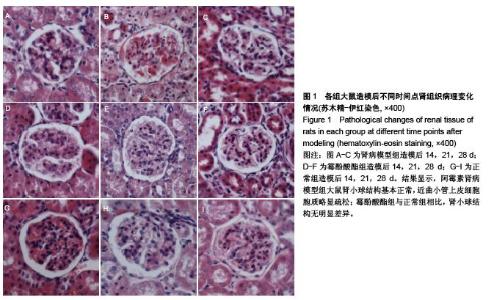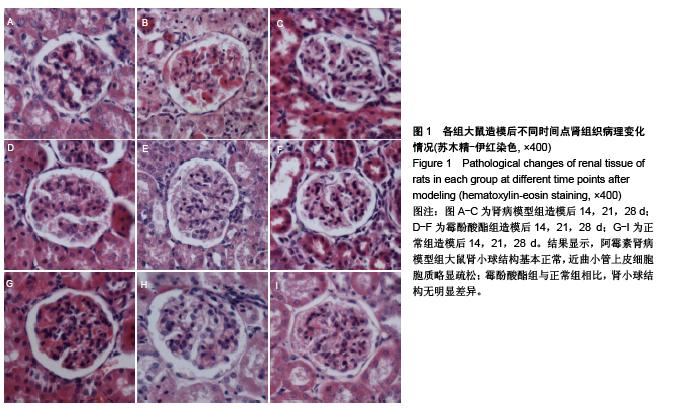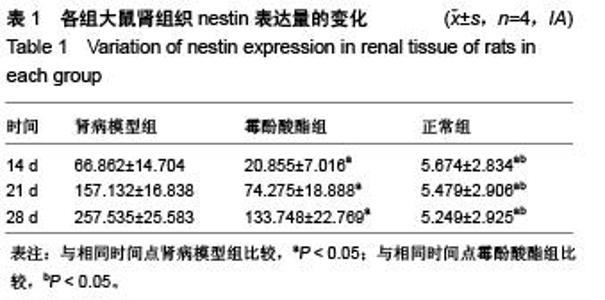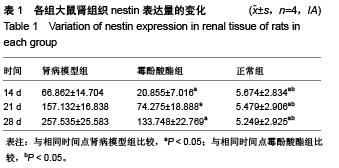Chinese Journal of Tissue Engineering Research ›› 2015, Vol. 19 ›› Issue (49): 8021-8025.doi: 10.3969/j.issn.2095-4344.2015.49.026
Previous Articles Next Articles
Expression of nestin in renal tissue of rat models of adriamycin nephropathy and the intervention of mycophenolate mofetil
Pan Feng-qi1, Jiang Hong2
- 1Department of Pediatrics, First Hospital of China Medical University, Shenyang 110001, Liaoning Province, China; 2Department of Pediatrics, Central Hospital Affiliated to Shenyang Medical College, Shenyang 110024, Liaoning Province, China
-
Received:2015-09-07Online:2015-11-30Published:2015-11-30 -
About author:Pan Feng-qi, Master, Attending physician, Department of Pediatrics, First Hospital of China Medical University, Shenyang 110001, Liaoning Province, China
CLC Number:
Cite this article
Pan Feng-qi, Jiang Hong. Expression of nestin in renal tissue of rat models of adriamycin nephropathy and the intervention of mycophenolate mofetil[J]. Chinese Journal of Tissue Engineering Research, 2015, 19(49): 8021-8025.
share this article
| [1] Oh J, Reiser J, Mundel P. Dynamic (re)organization of the podocyte actin cytoskeleton in the nephrotic syndrome. Pediatr Nephrol. 2004;19(2):130-137.[2] 王彦江,谢席胜,王宝福,等. 足细胞巢蛋白与糖尿病肾病蛋白尿发生机制的研究新进展[J].现代中西医结合杂志,2012,21(19): 2158-2161.[3] 刘巍,段惠军,张悦,等.中间丝蛋白Nestin在不同病程糖尿病大鼠肾组织中的表达[J].中国组织化学与细胞化学杂志,2011,20(4): 301-305.[4] Reiniger N,Lau K,McCalla D,et al.Deletion of the receptor for advanced glycation end products reduces glomerulosclerosis and preserves renal function in the diabetic OVE26 mouse. Diabetes.2010;59(8):2043-2054. [5] 尤莉,陈靖,苏蔚,等.巢蛋白在足突广泛融合的肾小球中表达下调及与蛋白尿程度的相关性[J].中华肾脏病杂志,2008,24(6): 405-410.[6] 管娜,丁洁,张敬京,等.肾病综合征患儿肾小球中nephrin、podocin、α-actinin及WT1的表达[J]. 肾脏病与透析肾移植杂志, 2002,11(3):205-210.[7] 苏蔚,陈靖,杨海春,等.足细胞中巢蛋白的表达及其相互作用分子的研究[J].中华肾脏病杂志,2006,22(7):406-410.[8] Geske P, Huber TB, Sellin L, et al. Homodimerization and heterodimerization of the glomerular podocyte proteins,nephrin and NEPH1. J Am Soc Nephrol.2003;14:918-926[9] Chen J, Boyle S, Zhao M, et al. Differential expression of the intermediate filemant protein nestin during renal development and its localization in adult podocytes. J Am Soc Nephrol. 2006;17:1283.[10] 张悦,魏民,王谦,等.阿霉素复制大鼠微小病变肾病模型的研究[J].北京中医药大学学报,2002,25(2):16-18.[11] 刘晓雅,任雅丽,管娜,等.阿霉素大鼠肾病模型足细胞线粒体体视学分析[J].中国体视学与图像分析,2014,18(4):365-373. [12] Abo-Salem OM. The protective effect of aminoguanidine on doxo- rubicin-induced nephropathy in rats. J Biochem Mol Toxicol. 2012,26(1):1-9.[13] 张勇,张蓓,宁华英,等.单次尾静脉注射法阿霉素大鼠肾病模型的建立[J].中国实验动物学报,2013,10(1):1-4.[14] Grimbert P, Audard V, Remy P, et al.Recent approaches to the pathogensis of minimal-change nephrotic syndrome. Nephrol Dial Transplant. 2003;18:245-248.[15] Dettmar AK, Binder E, Greiner FR, et al. Protection of human podocytes from shiga toxin 2-induced phosphorylation of mitogen- activated protein kinases and apoptosis by human serum amyloid P component. Infect Immun. 2014;82(5): 1872-1879.[16] 叶晓华,杨青,林瑞霞,等. 吗替麦考酚酯治疗小儿频复发肾病综合征的疗效观察[J].温州医学院学报, 2014,44(7):528-532.[17] Banerjee S,Pahari A,Sengupta J,et al.Outcome of severe steroid-dependent nephrotic syndrome treated with mycophenolate mofetil. Pediatr Nephrol. 2013;28(1):93-97.[18] Afzal K, Bagga A, Menon S, et al. Treatment with mycophenolate mofetil and prednisolone for steroid-dependent nephrotic syndrome. Pediatr Nephrol. 2007;22(12):2059-2065.[19] 贾立山,李晓忠.小儿微小病变肾病综合征免疫发病机制研究进展[J].临床肾脏病杂志,2013,12(11):488-491.[20] Wang L,Li Q, Wang LJ,et al. Level of Th17 cell and CIM(+) ; CD25 (+); Foxp3 (+); regulatory T cell in peripheral blood mononuclear cells of primary nephrotic syndrome in children. Xi Bao Yu Fen Zi Mian Yi Xue Za Zhi. 2010;26:783-786.[21] 颜思璐,宁岑.小儿原发性肾病综合征复发危险因素的相关性分析[J].广西医学,2013,35(6):753-754.[22] Le Berre L, Bruneau S, Naulet J,et al. Induction of T regulatory cells attenuates idiopathic nephrotie syndrome. J Am Soc Nephrol. 2009;20:57-67.[23] 马晓红,何立群.不同剂量阿霉素致大鼠局灶节段硬化肾病模型的建立比较[J].中国比较医学杂志,2013,21(1):37-42.[24] Patrie KM. Interaction of Two Aetin-binding Proteins, synaptopodin and alpha-Actinin-4, with the Tight Junction Protein MAGI-1. J Biol Chem. 2002;277(33):180-183. |
| [1] | Chen Ziyang, Pu Rui, Deng Shuang, Yuan Lingyan. Regulatory effect of exosomes on exercise-mediated insulin resistance diseases [J]. Chinese Journal of Tissue Engineering Research, 2021, 25(25): 4089-4094. |
| [2] | Chen Yang, Huang Denggao, Gao Yuanhui, Wang Shunlan, Cao Hui, Zheng Linlin, He Haowei, Luo Siqin, Xiao Jingchuan, Zhang Yingai, Zhang Shufang. Low-intensity pulsed ultrasound promotes the proliferation and adhesion of human adipose-derived mesenchymal stem cells [J]. Chinese Journal of Tissue Engineering Research, 2021, 25(25): 3949-3955. |
| [3] | Yang Junhui, Luo Jinli, Yuan Xiaoping. Effects of human growth hormone on proliferation and osteogenic differentiation of human periodontal ligament stem cells [J]. Chinese Journal of Tissue Engineering Research, 2021, 25(25): 3956-3961. |
| [4] | Sun Jianwei, Yang Xinming, Zhang Ying. Effect of montelukast combined with bone marrow mesenchymal stem cell transplantation on spinal cord injury in rat models [J]. Chinese Journal of Tissue Engineering Research, 2021, 25(25): 3962-3969. |
| [5] | Gao Shan, Huang Dongjing, Hong Haiman, Jia Jingqiao, Meng Fei. Comparison on the curative effect of human placenta-derived mesenchymal stem cells and induced islet-like cells in gestational diabetes mellitus rats [J]. Chinese Journal of Tissue Engineering Research, 2021, 25(25): 3981-3987. |
| [6] | Hao Xiaona, Zhang Yingjie, Li Yuyun, Xu Tao. Bone marrow mesenchymal stem cells overexpressing prolyl oligopeptidase on the repair of liver fibrosis in rat models [J]. Chinese Journal of Tissue Engineering Research, 2021, 25(25): 3988-3993. |
| [7] | Liu Jianyou, Jia Zhongwei, Niu Jiawei, Cao Xinjie, Zhang Dong, Wei Jie. A new method for measuring the anteversion angle of the femoral neck by constructing the three-dimensional digital model of the femur [J]. Chinese Journal of Tissue Engineering Research, 2021, 25(24): 3779-3783. |
| [8] | Meng Lingjie, Qian Hui, Sheng Xiaolei, Lu Jianfeng, Huang Jianping, Qi Liangang, Liu Zongbao. Application of three-dimensional printing technology combined with bone cement in minimally invasive treatment of the collapsed Sanders III type of calcaneal fractures [J]. Chinese Journal of Tissue Engineering Research, 2021, 25(24): 3784-3789. |
| [9] | Qian Xuankun, Huang Hefei, Wu Chengcong, Liu Keting, Ou Hua, Zhang Jinpeng, Ren Jing, Wan Jianshan. Computer-assisted navigation combined with minimally invasive transforaminal lumbar interbody fusion for lumbar spondylolisthesis [J]. Chinese Journal of Tissue Engineering Research, 2021, 25(24): 3790-3795. |
| [10] | Hu Jing, Xiang Yang, Ye Chuan, Han Ziji. Three-dimensional printing assisted screw placement and freehand pedicle screw fixation in the treatment of thoracolumbar fractures: 1-year follow-up [J]. Chinese Journal of Tissue Engineering Research, 2021, 25(24): 3804-3809. |
| [11] | Shu Qihang, Liao Yijia, Xue Jingbo, Yan Yiguo, Wang Cheng. Three-dimensional finite element analysis of a new three-dimensional printed porous fusion cage for cervical vertebra [J]. Chinese Journal of Tissue Engineering Research, 2021, 25(24): 3810-3815. |
| [12] | Wang Yihan, Li Yang, Zhang Ling, Zhang Rui, Xu Ruida, Han Xiaofeng, Cheng Guangqi, Wang Weil. Application of three-dimensional visualization technology for digital orthopedics in the reduction and fixation of intertrochanteric fracture [J]. Chinese Journal of Tissue Engineering Research, 2021, 25(24): 3816-3820. |
| [13] | Sun Maji, Wang Qiuan, Zhang Xingchen, Guo Chong, Yuan Feng, Guo Kaijin. Development and biomechanical analysis of a new anterior cervical pedicle screw fixation system [J]. Chinese Journal of Tissue Engineering Research, 2021, 25(24): 3821-3825. |
| [14] | Lin Wang, Wang Yingying, Guo Weizhong, Yuan Cuihua, Xu Shenggui, Zhang Shenshen, Lin Chengshou. Adopting expanded lateral approach to enhance the mechanical stability and knee function for treating posterolateral column fracture of tibial plateau [J]. Chinese Journal of Tissue Engineering Research, 2021, 25(24): 3826-3827. |
| [15] | Zhu Yun, Chen Yu, Qiu Hao, Liu Dun, Jin Guorong, Chen Shimou, Weng Zheng. Finite element analysis for treatment of osteoporotic femoral fracture with far cortical locking screw [J]. Chinese Journal of Tissue Engineering Research, 2021, 25(24): 3832-3837. |
| Viewed | ||||||
|
Full text |
|
|||||
|
Abstract |
|
|||||



